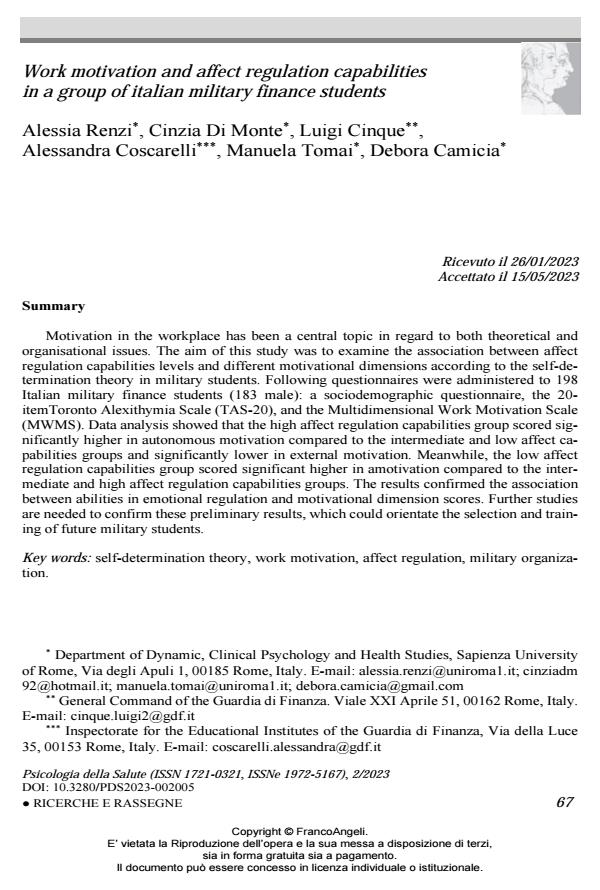Work motivation and affect regulation capabilities in a group of italian military finance students
Titolo Rivista PSICOLOGIA DELLA SALUTE
Autori/Curatori Alessia Renzi, Cinzia Di Monte, Luigi Cinque, Alessandra Coscarelli, Manuela Tomai, Debora Camicia
Anno di pubblicazione 2023 Fascicolo 2023/2
Lingua Inglese Numero pagine 17 P. 67-83 Dimensione file 266 KB
DOI 10.3280/PDS2023-002005
Il DOI è il codice a barre della proprietà intellettuale: per saperne di più
clicca qui
Qui sotto puoi vedere in anteprima la prima pagina di questo articolo.
Se questo articolo ti interessa, lo puoi acquistare (e scaricare in formato pdf) seguendo le facili indicazioni per acquistare il download credit. Acquista Download Credits per scaricare questo Articolo in formato PDF

FrancoAngeli è membro della Publishers International Linking Association, Inc (PILA)associazione indipendente e non profit per facilitare (attraverso i servizi tecnologici implementati da CrossRef.org) l’accesso degli studiosi ai contenuti digitali nelle pubblicazioni professionali e scientifiche
Motivation in the workplace has been a central topic in regard to both theoretical and or-ganisational issues. The aim of this study was to examine the association between affect regu-lation capabilities levels and different motivational dimensions according to the self-determination theory in military students. Following questionnaires were administered to 198 Italian military finance students (183 male): a sociodemographic questionnaire, the 20-itemToronto Alexithymia Scale (TAS-20), and the Multidimensional Work Motivation Scale (MWMS). Data analysis showed that the high affect regulation capabilities group scored sig-nificantly higher in autonomous motivation compared to the intermediate and low affect capa-bilities groups and significantly lower in external motivation. Meanwhile, the low affect regu-lation capabilities group scored significant higher in amotivation compared to the intermediate and high affect regulation capabilities groups. The results confirmed the association between abilities in emotional regulation and motivational dimension scores. Further studies are needed to confirm these preliminary results, which could orientate the selection and training of future military students.
La motivazione lavorativa è un topic centrale per quanto riguarda sia le questioni teoriche che quelle organizzative. L’obiettivo di questo studio è stato di valutare la relazione tra i livelli di regolazione affettiva e le diverse dimensioni della motivazione, secondo la teoria dell’autodeterminazione, negli allievi militari. A 198 allievi finanzieri italiani (183 maschi) so-no stati somministrati i seguenti questionari: un questionario sociodemografico, la 20-items Toronto Alexithymia Scale (TAS-20) e la Multidimensional Work Motivation Scale (MWMS). L’analisi dei dati ha mostrato che il gruppo con maggiori capacità di regolazione affettiva ha ottenuto punteggi significativamente più alti nella motivazione autonoma e più bas-si nella motivazione esterna rispetto ai gruppi con livelli di regolazione affettiva intermedi e bassi. Inoltre, il gruppo con bassi livelli di regolazione affettiva ha ottenuto un punteggio signi-ficativamente più alto nell’amotivazione ‒ definita come assenza di motivazione ‒ rispetto ai gruppi con livelli di regolazione affettiva intermedi e alti. I risultati hanno confermato l’associazione tra capacità di regolazione emotiva e la dimensione motivazionale. Ulteriori studi sono necessari per confermare questi risultati preliminari, che potrebbero orientare la selezione e la formazione dei futuri studenti militari.
Parole chiave:teoria dell’autodeterminazione, motivazione lavorativa, regolazione affettiva, organizzazione militare.
Alessia Renzi, Cinzia Di Monte, Luigi Cinque, Alessandra Coscarelli, Manuela Tomai, Debora Camicia, Work motivation and affect regulation capabilities in a group of italian military finance students in "PSICOLOGIA DELLA SALUTE" 2/2023, pp 67-83, DOI: 10.3280/PDS2023-002005